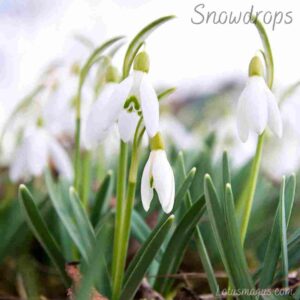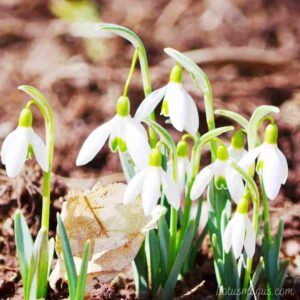Are you looking for a flower that is easy to grow and care for? If so, the snowdrop flower is the perfect choice! In this blog post, we will give you everything you need to know about growing and caring for snowdrop flowers. I will also share some tips on how to make your snowdrops last longer.
Snowdrops are a beautiful flowering plant that can make a winter garden look magical. While the flowers themselves are small, their little white heads overlooking dainty green leaves make them a popular choice for winter flower arrangements. However, the snowdrop’s fragility makes them a difficult plant to grow and care for. If you’re looking for a way to grow snowdrops, or just want to learn more about them, read on.
What is a Snowdrop?
Snowdrops can be an interesting flower to grow indoors or outdoors. It is usually a perennial flowering plant in the genus Galanthus. The snowdrop flower is one of the earliest flowering bulbs, with flowers typically appearing in late winter or early spring. The flowers come in white, pink, lavender, red, and purple. The flowers are about 2 inches in diameter and are often called “snowdrops” because of their resemblance to the flowers that bloom in the snow. The flowers are often seen as a sign of spring and are often used as a symbol of the season. Snowdrops are typically used in many different ways in the home, including as a houseplant.
Growing Snowdrop Flower

Snowdrops are one of the most beautiful flowers that you can grow in your garden. They are easy to grow, require little care, and are a great choice for beginners. To grow them, you will need to start them from seed indoors and then transplant them outdoors in early spring. You should plant them in the garden so that they will have plenty of sunlight. They will grow into beautiful flowers that will last for many months, if not all year long.
snowdrops (Galanthus) are a popular choice for early spring gardens. Though most snowdrops bloom in late winter or early spring, there are some varieties that bloom as early as December. Snowdrops are one of the first bulbs to bloom in the spring and will often push their way through the snow. These hardy plants are relatively easy to grow and care for, making them a great choice for both beginner and experienced gardeners alike.
There are several different ways to grow snowdrops. You can plant them in the ground or in pots, and they can be planted indoors or outdoors. If you live in an area with a mild climate, you can plant snowdrops directly in the ground. In harsher climates, it is best to start snowdrops indoors and then transplant them outdoors once they have started to grow.
When planting snowdrops, choose a location that receives partial sun to full shade. Snowdrops prefer moist, well-drained soil but will also tolerate drier conditions. If you live in an area with heavy clay soil, it is best to mix in some sand or organic matter before planting.
Once your snowdrops have been planted, they require very little maintenance. Water regularly during the growing season (spring and fall), but allow the soil to dry out between watering. Feed your snowdrops once a year with a balanced fertilizer such as 10-10-10. Snowdrops are relatively pest and disease resistant, but slugs and snails can be a problem in some areas. To control these pests, place bait around your plants or handpick them from your garden bed.
Snowdrop Flower Care

Snowdrops are a perennial plant that grows wild in Europe and Asia. They are typically grown in gardens and planted in pots and containers. They are a favorite plant for florists, and are typically used for weddings and other special occasions. Snowdrops are a hardy plant, easy to grow, and are relatively easy to care for. They need a well-drained soil, plenty of sun, and regular water. They also need a winter chill before they bloom.
Soil
Snowdrop flower require well draining and organic soil to grow and The soil should always be moist with helps the snowdrops to keep producing flowers. A good option of potting soil that is created using decomposition of plant leaves and other parts of plant waste. Another option is using a potting soil that is specially made for flowering plants.
Water
Either you can water snowdrops regularly or alternative days. The soil may dry early due to full sunlight that it gets for over 6 hours. So you should be watering it whenever the soil is dry. They can be watered less in colder climate area while the states that gets warm or extreme sunlight require more water than regular. Snowdrops require a lot of water to thrive. The water you give them should be poured directly onto the soil.
Light
A flowering plant like Snowflower enjoys a day full of sunlight and minimum they should get light for 6 hours per day. The best time for snowdrop flowers is during the summer. If you want to grow and care for snowdrop flowers, be sure to have a place that receives full sun. If you are unable to provide full sun, then you can use a grow light.
Temperature
When it comes to snowdrop flowers, the temperature is important. Snowdrops prefer to be between 55 to 75 degrees Fahrenheit. Snowdrop flowers prefer to be in a pot or basket, also in the ground.
Humidity
Snowdrop flowers require a humidity level of 50-60% to grow, thrive and flower. When the humidity level is below 50%, the flowers will be stunted. If the humidity is too high, the flowers will be prone to fungal disease and watering them too often can cause the flowers to split from the stem.
How to Plant Snowdrop Flower?
Snowdrop flowers are very easy to grow and require very little care. They are perfect for adding a touch of winter color to your garden. The best time to plant snowdrop bulbs is in autumn, before the first frost.
To plant your bulbs, simply dig a small hole in the ground, drop in the bulb and cover with soil. Water well and keep the soil moist until the plant starts to grow. Once the plant has flowered, cut back the dead flower heads and leave the leaves to die back naturally.
To encourage your snowdrops to flower again next year, feed them with a high-potash fertilizer in early spring.
Snowdrops are only available in the winter months. They are a short-lived flower that begins to die off in the spring. They are pretty easy to care for and will grow in any type of soil. If you have a small window, you can simply place the pot outside. If you don’t have a small window, you can place the pot in a sunny window indoors. It is important to keep the soil moist so that it doesn’t dry out. If you want to keep the flower alive longer, you should put a plastic bag around the pot so that it can’t dry out.
How to Deadhead Snowdrop Flowers
generally speaking, snowdrops do not need deadhead which requires in lilies. The snowdrops flowers die back on their own and drop on the soil. With so many years They either continue to grow or die but doesn’t require any deadheading. I know Deadheading not only allows you to enjoy a successful flowering again but in case of snowdrops you just don’t need that. Its one of the reasons why snowdrops become popular due to their low mainatance and caring.
Snowdrop Flower Types
The snowdrop flower is one of the first blooms of spring. Learn more about types of snowdrops, snowdrop colors and the meaning of this delicate flower. Snowdrops (Galanthus) are among the first flowers to bloom in spring. They are small, delicate and white with a green mark on the inner petals.
There are many different types of snowdrops, each with its own unique appearance. The most common type is the common snowdrop (Galanthus nivalis), which is native to Europe. Other popular varieties include:
- Giant snowdrop (Galanthus elwesii)
- Hoary snowdrop (Galanthus hoggii)
- Lady Elgin snowdrop (Galanthus plicatus ‘Lady Elgin’)
- New England snowdrop (Galanthus spitzii)
- Six-week snowdrop (Galanthus nivalis ‘Flore Pleno’)
The flowers of most varieties are white, but some have yellow or green markings on the inner petals. Snowdrops are very fragrant and make excellent cut flowers for indoor arrangements.
The best time to plant snowdrop flowers
The best time to plant snowdrop bulbs is in late summer or early fall, before the first frost. You can also plant snowdrop bulbs in the spring, but they may not bloom as early or as profusely. Choose a site that receives full sun to partial shade and has moist, well-drained soil.
To plant, dig a hole that is twice the width of the bulb and just deep enough so that the bulb is seated at soil level. Planting several bulbs together will give you a more impressive display. After planting, water your bulbs well and mulch with a layer of straw or leaves.
Snowdrop flowers typically bloom in late winter or early spring. The blooming period lasts for about 2-3 weeks. To extend the blooming period, plant different varieties of snowdrops that bloom at different times.
These flowers are relatively low maintenance and are not susceptible to many pests or diseases. However, deer and rabbits may nibble on the leaves, so take precautions if you have these animals in your area.
Pests and Diseases
Unfortunately, snowdrop flowers are not immune to pests and diseases. Common problems include aphids, slugs, and diseases such as snowdrop rust.
Propagating Snowdrops
When propagating Snowdrops you can either use seeds method or divide bulbs of snowdrops with roots. Moreover Snowdrops are naturally begin to multiply and grow in the enviorment. Propagating snowdrops from bulbs is used to grow them in next season.
Where to buy Snowdrops?
You can buy snowdrops from amazon and local nursery. If you don’t get the seeds or bulbs of snowdrops flower then I suggest to go and buy from the below links.
Snowdrop flower arrangements
Snowdrop flower arrangements are very popular, but they can be tricky to get right. Here are some tips on how to grow and care for your snowdrops so that they will thrive in your home.
When deciding on a location for your snowdrops, choose an area that receives direct sunlight for at least 6 hours each day. If you live in a colder climate, it is best to plant your snowdrops in order to avoid frost damage.
It is important to water your snowdrops regularly, especially during the hot summer months. Make sure to provide enough drainage so that the roots do not become waterlogged.
Feed your snowdrops with a balanced fertilizer every 2 weeks during the spring and summer growing season.
To encourage re-blooming, deadhead spent flowers as soon as they begin to fade.
When the leaves of your snowdrops begin to yellow and wither, this is an indication that it is time to dig up the bulbs and store them in a cool, dry place until next year.
Final thoughts
To make the most of your flowers, you’ll need to take good care of them. Here at How to Grow, Care and Plant Snowdrop Flowers, we provide care tips, so you can make these beautiful flowers last as long as possible, whether they’re in your backyard or on your window sill. Follow these tips and your flowers will grow into something beautiful! If you want to read similar article check below.
Also Read : Snowdrop Flower meaning and symbolism
